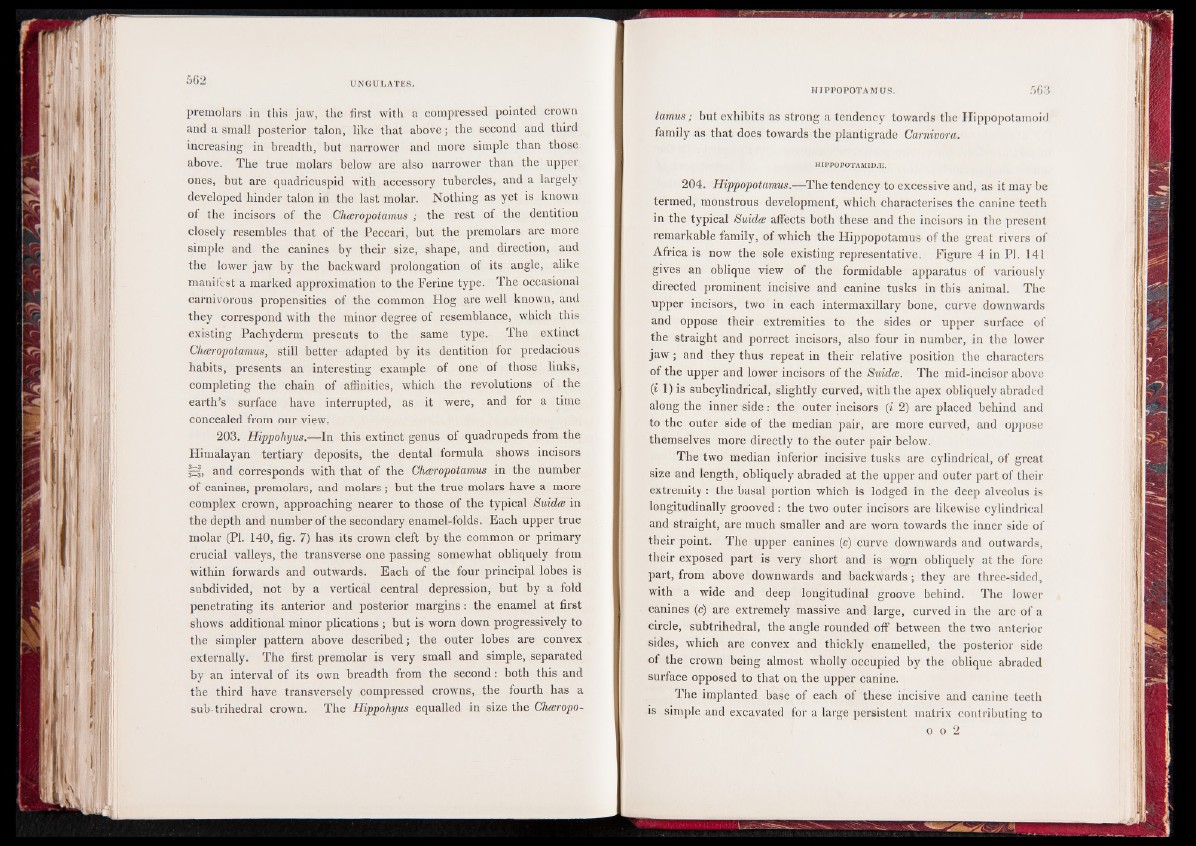
premolars in this jaw, the first with a compressed pointed crown
and a small posterior talon, like that above; the second and third
increasing in breadth, but narrower and more simple than those
above. The true molars below are also narrower than the upper
ones, but are quadricuspid with accessory tubercles, and a largely
developed hinder talon in the last molar. Nothing as yet is known
of the incisors of the Chceropotamus ; the rest of the dentition
closely resembles that of the Peccari, but the premolars are more
simple and the canines by their size, shape, and direction, and
the lower jaw by the backward prolongation of its angle, alike
manifest a marked approximation to the Ferine type. The occasional
carnivorous propensities of the common Hog are well known, and
they correspond with the minor degree of resemblance, which this
existing Pachyderm presents to the same type. The extinct
Chceropotamus, still better adapted by its dentition for predacious
habits, presents an interesting example of one of those links,
completing the chain of affinities, which the revolutions of the
earth’s surface have interrupted, as it were, and for a time
concealed from our view.
203. Hippohyus.—In this extinct genus of quadrupeds from the
Himalayan tertiary deposits, the dental formula shows incisors
and corresponds with that of the Chceropotamus in the number
of canines, premolars, and molars; but the true molars have a more
complex crown, approaching nearer to those of the typical Suidce in
the depth and number of the secondary enamel-folds. Each upper true
molar (PI. 140, fig. 7) has its crown cleft by the common or primary
crucial valleys, the transverse one passing somewhat obliquely from
within forwards and outwards. Each of the four principal lobes is
subdivided, not by a vertical central depression, but by a fold
penetrating its anterior and posterior margins: the enamel at first
shows additional minor plications ; but is worn down progressively to
the simpler pattern above described; the outer lobes are convex
externally. The first premolar is very small and simple, separated
by an interval of its own breadth from the second: both this and
the third have transversely compressed crowns,_ the fourth has a
sub-trihedral crown. The Hippohyus equalled in size the Char op o-
HIPPOPOTAMUS. 563
tamus; but exhibits as strong a tendency towards the Hippopotamoid
family as that does towards the plantigrade Carnivora.
HIPPOPOTAMIDjE.
204. Hippopotamus.—The tendency to excessive and, as it may be
termed, monstrous development, which characterises the canine teeth
in the typical Suidce affects both these and the incisors in the present
remarkable family, of which the Hippopotamus of the great rivers of
Africa is now the sole existing representative. Figure 4 in PI. 141
gives an oblique view of the formidable apparatus of variously
directed prominent incisive and canine tusks in this animal. The
upper incisors, two in each intermaxillary bone, curve downwards
and oppose their extremities to the sides or upper surface of
the straight and porrect incisors, also four in number, in the lower
jaw ; and they thus repeat in their relative position the characters
of the upper and lower incisors of the Suidce. The mid-incisor above
(i 1) is subcylindrical, slightly curved, with the apex obliquely abraded
along the inner side: the outer incisors (i 2) are placed behind and
to the outer side of the median pair, are more curved, and oppose
themselves more directly to the outer pair below.
The two median inferior incisive tusks are cylindrical, of great
size and length, obliquely abraded at the upper and outer part of their
extremity: the basal portion which is lodged in the deep alveolus is
longitudinally grooved : the two outer incisors are likewise cylindrical
and straight, are much smaller and are worn towards the inner side of
their point. The upper canines (c) curve downwards and outwards,
their exposed part is very short and is wqjpn obliquely at the fore
part, from above downwards and backwards; they are three-sided,
with a wide and deep longitudinal groove behind. The lower
canines (c) are extremely massive and large, curved in the arc of a
circle, subtrihedral, the angle rounded off between the two anterior
sides, which are convex and thickly enamelled, the posterior side
of the crown being almost wholly occupied by the oblique abraded
surface opposed to that on the upper canine.
The implanted base of each of these incisive and canine teeth
is simple and excavated for a large persistent matrix contributing to
o o 2